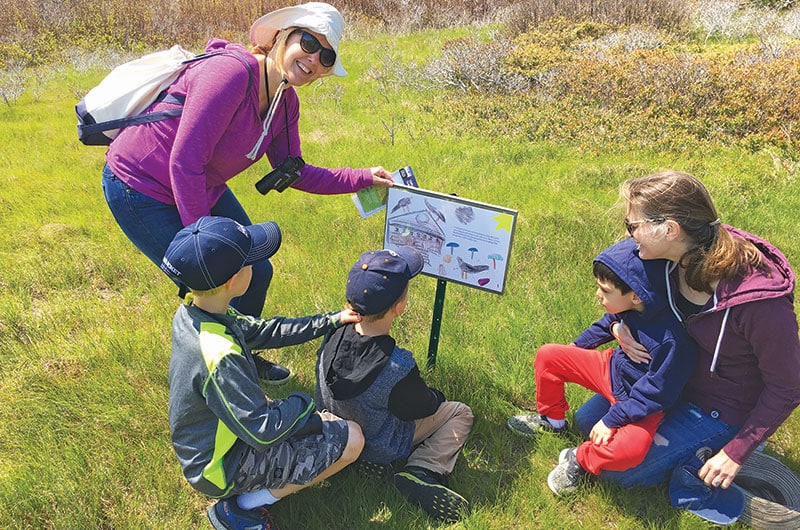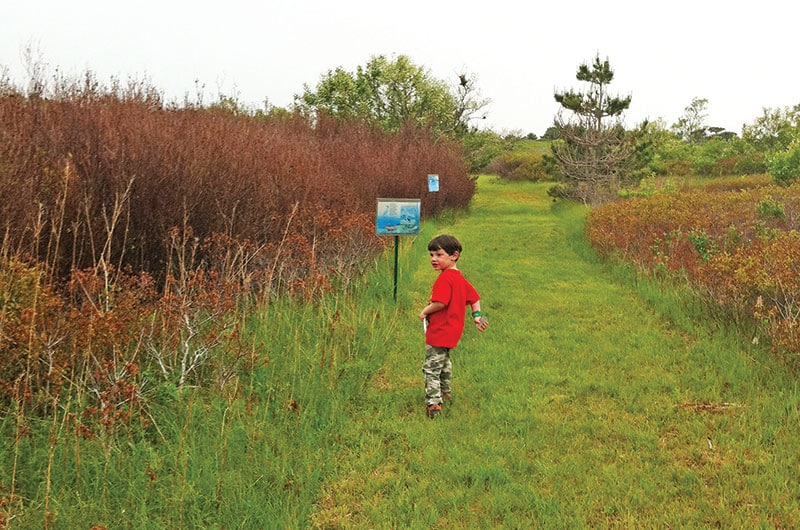Dr. Sarah Treanor Bois
Director of Research & Education at the Linda Loring Nature Foundation
Have you ever wondered about sand fleas and if they would help you out if you were in a bind? Well, that’s what students from the Nantucket New School’s (NNS) first and sixth grades were thinking about when they dreamed up their latest story creation, Sand Fleas Save the Day.
Not to give too much away, Sand Fleas Save the Day is the story of Sandy the sand flea and how she and her sand flea pals rescue Berry, the Great Black-Backed Gull who has found himself in a predicament. Along the way they all learn a moral lesson while also learning something about nature on Nantucket.
This story is the result of a year-long collaboration between the NNS first and sixth grades and the Linda Loring Nature Foundation (LLNF). This is the fourth in a series of this collaboration.
Each year starts with me and Seth Engelbourg of LLNF working with the students to teach them about various aspects of nature on the island. We’re hoping to educate the students about what’s in their backyard: the habitats, plant communities, and animals that can be found on the island year-round. After several bi-weekly nature lessons and a field trip or two, we then talk about our favorite nature-based children’s stories. In many of these stories, such as Eric Carle’s The Tiny Seed, nature is personified and a lesson is often learned.
There is also some factual information about the nature itself. In The Tiny Seed, for example, we learn about what it takes for a seed to grow. It has to have the right combination and conditions for soil, moisture, and temperature to germinate. Then the tiny plant has to survive predation, trampling, and being picked in order to grow enough to reproduce. Examples like this one help the students frame their own story.
With examples in mind and many lessons on the flora and fauna of Nantucket, the story ideas take shape around the holidays. Sometime after New Year’s, teams of 6th graders propose their story ideas to the group. They present a general outline of the story, the main characters, and what habitat the story takes place in. There are usually three or four story ideas for the group to vote on. All the students (first and sixth grades), the teachers, as well as Seth and I participate in the vote. The story idea with the most votes is then selected to be made into the finished product by the group.
This year’s story deviates from the choices of the past few years: it is the first story to take place on the beach. Sand fleas may seem like an unusual choice for a protagonist, however, the team effort they use and their willingness to help other animals (in the story at least) make them great candidates for a tale about helping others in need.
Like many of the past stories, aspects of the narrative are worked out as a group with sixth graders and teacher Rachael Sullivan leading the charge. Lots of research goes into the natural history and biology of the flora and fauna incorporated in the story. Everything is as accurate as possible, including the time of day the animals are active, the size ratios of individuals, and what types of species we have on Nantucket.
As the narrative of the story takes shape with the sixth graders, the first graders set to work on the illustrations. With the guidance of first grade teacher Brenda Genthner, these six- and seven-year-olds detail the life and death struggles of birds, turtles, caterpillars, and other insects. Using detailed shading techniques, the students are guided by photographs of the animals in the story to get every detail right.
This year, sand fleas were a new creature to everyone involved. A lot of work had to be done on perspective. How big should any one sand flea or a group of sand fleas be?
Once all of the illustrations and text are complete and edited, the pieces are all put together. Pages are scanned and laminated and then posted on wooden boards. The boards are set up along the Linda Loring Nature Foundation’s walking trail on the short loop. The pages are separated by about 10 to 15 yards or so, encouraging all to take an extra step in nature.
Past stories created by this same collaboration have included The Mouse and the Turtle, Carrot the Brave Bunny, and A Caterpillar’s Tale; Life at the Linda Loring Nature Foundation.
Once the narrative is complete, the story is then translated into Spanish with the help of a translator at the Nantucket Community School. The translation is available at the trail head for anyone to take along with them as they enjoy the story walk.
So, are you ready to find out what happens to Berry the Great Black-backed Gull and how exactly sand fleas save the day? Head out to the Linda Loring Nature Foundation at 110 Eel Point Rd. The trail is free and open sunup to sundown every day. Sand Fleas Save the Day will be posted through mid-July, so you have plenty of time to head out when the weather is good.




